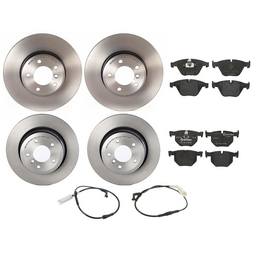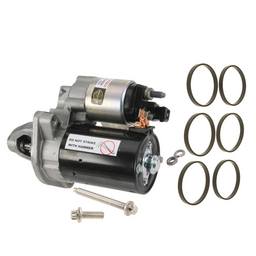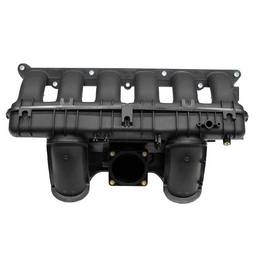There’s one interesting dilemma that’s bugging certain BMW owners. More specifically, those who own a bimmer with an inline-six gasoline engine built from 2004 to 2015. We’re talking about the 2.5-liter and 3-liter legend that is the BMW N52 engine. There’s nothing wrong with the engine itself. However, there’s also the ever so mysterious N51 that is very similar to the N52to the point that they are borderline impossible to tell apart. Things wouldn’t be so confusing if these two variations of the same engine weren’t both sold all across the United States. As a result, it’s hard to tell whether you have one or the other. This guide aims to resolve the N52 vs. N51 question and show you how to tell these engines apart.
Continuing the Legacy of Straight Six Wonders
The legendary M54 was a beacon of hope for all fans of BMW’s straight-six engines. This naturally aspirated beast came with plenty of headroom, which many modders were quick to take advantage of. Once it retired in 2006, it marked an end of an era.
At the time, many saw it as the ‘last real straight-six engine’ retiring along with the ‘last real 3-series’. Although overblown from today’s perspective, this sentiment was widespread as the so-called Chris Bungle era of BMW was slowly ushered in.

Overall, the newly released N52 had some big shoes to fill. The engine had brought a number of design changes that have made it significantly different from its predecessor. One of the most significant changes was the use of magnesium composite in the engine block. BMW was looking for ways to make the engine lighter without sacrificing durability or performance.
They came to the idea of using magnesium instead of aluminum. However, since magnesium is more susceptible to corrosion than aluminum, the engineers at BMW came up with a design incorporating a magnesium shell surrounding an aluminum core.
Back then, that was pretty out there in terms of engine architecture. One of the less appreciated changes was the use of electric water pumps instead of mechanically driven ones. This was seen as a potential weak point of the engine, which turned out to be true to an extent.
There’s a whole lot more that separates the N52 from the M54. Despite all of the outlandish solutions that went into the new engine, it had entirely preserved the attitude of a traditional Bavarian straight-six.
ULEV and SULEV Engines
Emission regulations have become one of the cornerstones of engine design. Long gone are the days when you could build a gas guzzler powerhouse and tune it with zero respect to what’s coming out the tailpipe. In Europe, the entire continent runs on the Euro 1-6 emissions scale with almost every country upholding the same regulations. Things are a little different in the US.
In the US, there are so-called Ultra Low Emissions Vehicles and Super Ultra Low Emissions Vehicles. When BMW first started shipping the N52, it matched the ULEV requirements making it road legal in a number of states that insist on these emissions standards.
Seeing how there’s a great deal of autonomy left to individual states when it comes to emissions regulations, some have decided to make SULEV the lowest acceptable standard. This has put BMW in a position where they had to modify the original N52 and create what is now known as the N51 engine.
Keep in mind that vehicles with N51 and those with N52 are nearly identical. We say nearly because there are several key areas where these engines differ. If you were to go buying parts for an N52 only to get those for the N51, you could find yourself in trouble.
Okay, so you can figure out which engine is in your car based on the state you’re in, right? If only it was that easy! There are numerous cases of both types of engines creeping into states where they’re technically not supposed to be – at least the N52. The much ‘cleaner’ N51 naturally meets the ULEV requirements, so you’ll find those just about anywhere.
The Main Differences Between the N51 and N52 Engines
The engines were installed in a whole array of different BMW vehicles from 2006 to 2015. You’ll find them in 1, 3, 5 Series, as well as Z and X series cars. One easy way to figure out which engine you don’t have is to know what kind of displacement you’re working with. N51 only came as a 3-liter, meaning that any 2.5-liter inline-six of this generation is going to be N52.
With that said, here are some of the main differences between the two engines:
- Cylinder Head– Both N52 and N51 run aluminum heads, but the one found on N51 is specific due to the combustion chamber modifications that were made to meet the SULEV standards. They are not interchangeable.
- Cylinder Head Cover – The cylinder head cover on N52 is made of magnesium while the one on N51 is made of plastic and has integrated crankcase ventilation.
- Crankcase Ventilation – The N52 features an external crankcase vent valve complete with cyclone separator. The N51, as mentioned above, has an integrated vent valve, labyrinth, and cyclone oil separation.
- Intake Manifold – The intake manifold on N52 is plastic with a 3-stage DISA valve on more powerful versions. The one on N51 is a 3-stage DISA unit used to compensate for different compression.
- Piston/compression Ratio – For N52, you’re looking at 10.7:1 while the ration for N51 comes in at 10:1.
- Hot Film Meter – N52 has an analog HFM while the N51 uses a digital one.
The issue is that despite all of these differences, there’s no way to tell these engines apart if you simply pop the hood to take a look. It’s not like it was on M56 and M54 generation. The M56 SULEV was visually different compared to the M54, so you could easily tell.
But, there is a way. The easiest way to identify which engine you’re dealing with is to take a gander at the vehicle emissions plate under the hood. You’ll notice the relevant info on the left-hand side of the plate in the third row. N52 will be marked as LEV, while the N51 carries a SULEV tag.
The states that required SULEV compliant vehicles include:
- Arizona
- Connecticut
- California
- District of Columbia
- Maine
- Maryland
- Massachusetts
- New Mexico
- New York
- New Jersey
- Oregon
- Pennsylvania
- Rhode Island
- Vermont
- Washington
Which Engine is Better – The N52 or N51?
There’s a lot of noise being generated around these two engines as people are trying to figure out which one is better. Power-wise, there isn’t much difference. Both are tuned to deliver the same power and torque.
However, there are always people out there who are claiming that their 3-stage intake, DISA valve equipped N51 has a better throttle response and more pull as it reaches around 3,000 RPM. The logic here is that having a beefier intake manifold makes the difference.
The reason that manifold is there in the first place is to give the engine a bit more kick due to the inherently lower compression on the N51.
If you listen to those on the other side of the isle, they’ll say that the N51 is actually slower. In their eyes, all of the mods made to meet emissions standards are choking the engine and cutting down on its performance.
The truth is somewhere in-between. If you don’t plan on doing serious engine tuning, you most likely won’t feel the difference. The maintenance for both engines is similar, although the N51 has a few more bells and whistles that need to be accounted for, mostly on the exhaust side of the package.
What you should be paying attention to is making sure that your parts match your engine.
Finding the Correct Parts for Each Engine Type
Considering how similar the N51 and N52 are to each other, there’s always a risk that you’ll get the wrong part for your car. One way to be sure is to use the navigation tools in our store. The first option is to input your car’s make model and year.
That should get you close enough. However, since some of the models overlap, the only proven method is to use our VIN tool. Simply input your VIN into the specified field, and you’ll receive the parts that match your car. In case you’re not sure which engine you have, feel free to get in touch with us via our contact page. Our team is standing by to offer assistance and get you the parts you’re looking for!








Hello,
For a 2013 328i SULEV convertible (E93/N51):
Is PCV valve failure (symptom being a whistling noise) covered by SULEV warranty?
Is Radiator replacement (due to leaks) covered by warranty?
Thanks
RB
I have a 2007 ULEV 3.0 and a 2011 SULEV 3.0 in 328XI’s. Both have plastic valve covers and appear to have the same PCV valve built in to the cover. The intake manifolds appear identical, but maybe I can’t see the difference. Also, both were sold new in New York. Maybe New York did not require the SULEV until later?